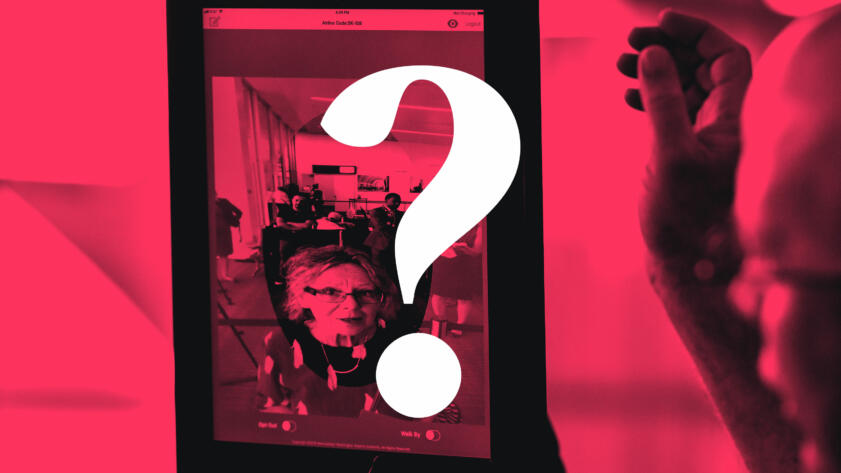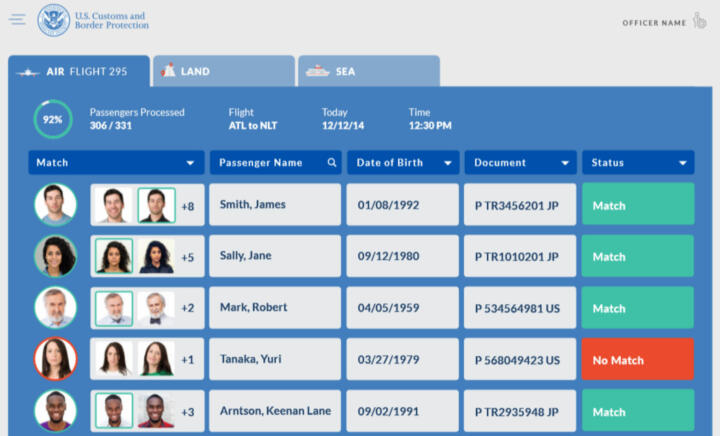At airports around the world, there has been significant growth in the use of biometric facial scans to verify travelers’ identities. In the United States, the technology is employed both by officials at Customs and Border Protection (CBP) to identify people entering and leaving the country and by a handful of airlines in lieu of boarding passes on international flights.
Airlines say passengers’ swapping faces for tickets speeds up the boarding process. The federal government asserts biometrics can reduce wait times and missed flights as the number of travelers moving through space-constrained airports swells.
If the idea of the government, or an airline, identifying you with facial recognition makes you queasy, you should know that the process isn’t always mandatory. All of the airlines using facial biometrics in the U.S.—JetBlue, Delta, American Airlines, British Airways, and Lufthansa—say they allow passengers to voluntarily opt out. When scans are conducted by CBP officials, things get a little more complicated.
Entering the country, U.S. and Canadian citizens—along with travelers under the age of 14 or over the age of 79, and holders of a smattering of specific visas—can go to an Automated Passport Control kiosk, which takes a travelers’ picture but doesn’t make use of facial biometrics, according to a CBP spokesperson. Everyone else has to go through the standard customs process, which includes a facial biometric scan, at least at the 14 domestic airports and four airports in other countries where the technology has been deployed.
What Airports Are Using This Technology?
Here’s a list:
- Abu Dhabi, United Arab Emirates (AUH)
- Aruba (AUA)
- Atlanta (ATL)
- Detroit (DTW)
- Dublin, Ireland (DUB)
- Ft. Lauderdale (FLL)
- Houston (HOU)
- Houston (IAH)
- Las Vegas (LAS)
- Los Angeles (LAX)
- Miami (MIA)
- New York (JFK)
- Orlando (MCO)
- San Antonio (SAT)
- San Diego (SAN)
- San Jose (SJC)
- Shannon, Ireland (SNN)
- Washington, D.C. (IAD)
“More than 42 million travelers have been processed using facial comparison technology,” a CBP spokesperson told The Markup, noting that all passengers leaving the country are able opt out of biometric scanning at their boarding gates. “Travelers who wish to opt out of the new biometric process may notify a gate agent or CBP officer during the boarding process and request the manual document check that is required for international air travel.”
Yet, refusing a facial scan, anywhere in an airport, isn’t always straightforward. Some travelers who have elected to do so report delays and confusion from airport staff, making each decision to opt out a bit of a gamble when you’re racing to catch a flight.
What Exactly Is a Biometric Facial Scan?
Biometric facial recognition works by taking a photo of someone’s face and then using an algorithm to measure dozens of distinct features, like the distance between the eyes. These identifiers are stored in a database. When someone undergoes a biometric facial scan, the algorithm logs that same set of identifiers and compares it with the database to determine if there’s a match.
The government began using facial biometric scans as part of post-9/11 terrorist prevention measures. Airlines send CBP a list of all the passengers on departing international flights. CBP then pulls the passport photos, or images from other travel documents, of those travelers into a database that compares them with the in-person facial scans conducted at the airport.
The CBP says it deletes the facial recognition photos taken of U.S. citizens within 12 hours of a successful match, but records of when U.S. citizens (or lawful permanent residents) entered or left the country are stored for 15 years. The information of non-immigrant aliens is retained for 75 years.
The airlines that employ facial recognition for boarding are using the same CBP database to match their passengers’ photos with the gallery of passport photos.
In an email to The Markup, JetBlue representative Julianna Bryan said the airline’s system doesn’t show them images from the CBP database. The airline only receives a notice from CBP saying whether the match was positive or negative. “If no match is found, an error message will be shown, and the customer will be directed to visit the podium to have their passport manually inspected and boarding pass scanned,” Bryan said.
A CBP spokesperson told The Markup that a challenge to implementing a nationwide system is that many U.S. airports are designed with terminals that commingle domestic and international flight gates. “To overcome these challenges, CBP is partnering with airlines and airports to incorporate biometric facial comparison technology seamlessly into their boarding processes,” he said.
But privacy advocates say that the technology isn’t ready for widespread usage, particularly given that it often does not work well with the faces of people of color. A 2019 study by the National Institute of Standards and Technology evaluated 189 facial recognition algorithms and found higher rates of false positives for Asians and African Americans than for Caucasians, with a differential of 10 to 100, depending on the algorithm.
“[People of color] are going to bear the brunt of the inaccuracy of the facial recognition algorithm,” said Jeramie Scott, director of the Domestic Surveillance Project at the Electronic Privacy Information Center. “Facial recognition technology is not ready to be implemented where it is making a decision whether someone can get on a plane.”
What Is Supposed to Happen When I Opt Out?
Passengers can say that they do not want to be scanned. Both with CBP and at the flight gate, officials are then supposed to look at the passenger’s passport with their eyes, compare it with the face of the person in front of them, scan the document to make sure it is legitimate, and then send the passenger on his or her way.
What Actually Happens When I Opt Out?
The Markup spoke with several people who have opted out of facial biometrics at airports, and the results vary.
In January, Varoon Mathur was taking a Delta flight from New York’s JFK Airport to Paris. Waiting in line to board, he noticed a sign about the facial scans and his ability to opt out. A researcher studying the social implications of machine learning at the AI Now Institute, Mathur understands “how pernicious and powerful these tools can be, and so being in a database is not really in my best interest,” he said.
When Mathur told the airline’s employees at the gate that he didn’t want to be scanned, he was informed that he would be unable to board the plane. He was told to wait while the crew figured it out and the rest of the passengers boarded. Mathur said he waited for about 15 minutes, going back and forth with Delta personnel, who were insistent about his not being able to board without the scan, before he relented and turned to face the camera.
“It was clear that proper instructions or a clear understanding of what agency a passenger had at that moment was not communicated to them at all,” Mathur said.
Delta declined to comment on Mathur’s experience, but what happened to him is not universal, even on Delta.
Allie Funk, a research analyst at the human rights nonprofit Freedom House, elected to opt out on a recent Delta flight to Tokyo because, she told The Markup, she feels a moral obligation to push back against technical systems of surveillance, even in small ways. Funk tweeted about opting out, and her story went viral.
Funk said airline staff told passengers to put their passports away because they were doing facial scans, but she doesn’t recall hearing anyone say anything about travelers’ ability to opt out. Funk wrote in Wired that in order for her to figure out how to decline the facial scan, “I had to leave the boarding line, speak with a Delta representative at their information desk, get back in line, then request a passport scan when it was my turn to board.”
She informed employees at the gate that she was going to opt out, and they just scanned her passport without any further delay. “It only took maybe another couple seconds compared to everyone else who was getting on the flight,” she told The Markup.
What Can I Do if I’m Denied an Opt-out
Zahra Billoo, an attorney with the civil rights group the Council on American-Islamic Relations, said travelers should “insist” on speaking with a supervisor if they are denied their request to opt out.
“In our experience,” Billoo said, “the supervisors will respect the assertion. It can take longer.”
Billoo often counsels people who experience issues getting through airport security. At airports she regularly opts out of certain screening procedures or refuses to answer questions that aren’t legally required. It’s a way for her to stress-test the system to see where it might be failing her clients, she said.
Last November, while traveling back from vacation in Mexico, Billoo decided to conduct one of her stress tests at San Diego International Airport. She told the CBP official at the counter that she wanted to opt out of the facial scan.
“It turns out I was his first opt out,” Billoo said. “He didn’t know what to do, and he called over a supervisor.”
She ended up going through a secondary verification process that involved some questioning, a bunch more confusion from CBP officials, and having to produce two forms of ID verifying her identity before she was allowed through to catch her flight.
The whole process took about an extra five to 10 minutes, but she said she could see how the experience could be intimidating for someone or drag on for far longer than what she experienced.
The airport can be a stressful place; travelers are often in a time crunch. It forces them into a difficult position: assert their right to opt out, but risk a delayed check-in process.
Even so, Billoo urges anyone with the ability to opt out to do so. “If we don’t, it’s a lot harder for the person who literally can’t because they’re not a U.S. citizen. What good is our privilege if we’re not willing to put it to risk?”
Do you have a question for Ask The Markup? Email us at ask@themarkup.org






